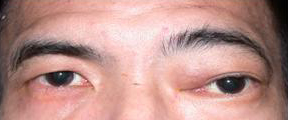What is - Orbital Tumours and Disorders
The orbit refers to the bony cavity in the skull that houses the eye and its surrounding structures (tear gland, muscles, nerves, blood vessels, etc.). Tumour means swelling, growths and masses.
Orbital tumours are swellings or abnormal growths arising from the tissues within the orbit. It can be an independent disease process or as part of a systemic illness that affects multiple tissues or organs in the body.
Some signs of orbital disorders include:
- Protrusion of the eyeball
- Pain
- Diplopia or double vision
- Loss of vision
- Redness and swelling of the eyelids
What are the various types of orbital disorders?
The various types of orbital disorders can be classified into the following categories:
Inflammatory disorders
- Infectious
- Non-infectious
- Acute
- Chronic
Neoplastic disorders
- Benign growth
- Malignant growth
For neoplastic disorders, they can occur in both children and adults.
| Children | Adults | ||
| Benign | Malignant | Benign | Malignant |
| Dermoid cyst | Rhabdomyosarcoma | Meningioma | Lymphoma |
| Fibrous dysplasia | Ewing's sarcoma | Optic nerve glioma | Metastases |

Patient with left upper lid swelling and fullness

Patient with left eye protrusion
Orbital imaging (CT and MRI scan) is often needed in diagnosis, and biopsy is frequently warranted to aid in diagnosis and formulating management plan of these patients.
Inflammatory disorders (infectious and non-infectious)
(a) Infections
Orbital infections or cellulitis can be due to bacterial, fungi or parasitic organisms.
It can result from infection of the adjacent sinuses, periocular region or contamination from direct trauma. This is an ophthalmic emergency requiring hospital admission and antibiotic treatment as spread of the infection to the brain can be life-threatening. Surgery drainage of the pus collection (abscesses) may be necessary.

Child with left orbital cellulitis presenting with fever and left eye swelling and redness
(b)Non-infectious inflammatory disorders
The cause of orbital inflammation can be idiopathic and localised or as part of systemic inflammations like: Wegener’s Granulomatosis, systemic lupus erythematosus (SLE), sarcoidosis and Sjogren’s Syndrome.
Orbital inflammations usually requires biopsy and blood tests to reach a specific diagnosis. Treatment usually involves the use of anti-inflammatory drugs or immunosuppressive agent. Surgical debulking and radiotherapy may be required in selected cases.

Patient with left orbital inflammation presenting with left eye swelling
and redness (non-specific inflammatory disorder of the lacrimal gland)
Neoplastic disorders
Neoplastic disorders of the orbit include congenital deformities such as dermoid cysts, benign structural disorder like lymphangioma, as well as acquired disorders like malignant lacrimal gland cancer.
They often affect the eye position causing bulging or displacement. In some cases, the nerves and muscles can be affected resulting in movement disorder and double vision.
Comprehensive history-taking, clinical assessment and radiological imaging are crucial in making the right diagnosis. These lesions can be left alone if they are benign and do not cause impairment or may be excised with further adjuvant treatment in malignant cases.
Contributed by
The information provided is not intended as medical advice. Terms of use. Information provided by SingHealth.
Get to know our doctors at SingHealth Hospitals in Singapore.
Get to know our doctors at SingHealth Hospitals in Singapore. here.




















